FRIDAY, SEPTEMBER 4
■ Jupiter and Saturn, shining in the south, turn horizontal in twilight. Every evening they get this way a few minutes earlier. The pair tilts to the right as evening advances.
■ The waning gibbous Moon rises around the end of twilight this evening. Once it's up, watch for fiery Mars, now unusually bright at magnitude –2.0, to rise about a fist-width or a little more (13°) to the Moon's lower left. Mars will come up about 30 or 40 minutes after the Moon if you live in the mid-latitudes of North America.
Over the Moon is the Great Square of Pegasus, balanced on one corner. The whole scene climbs higher as evening grows late.
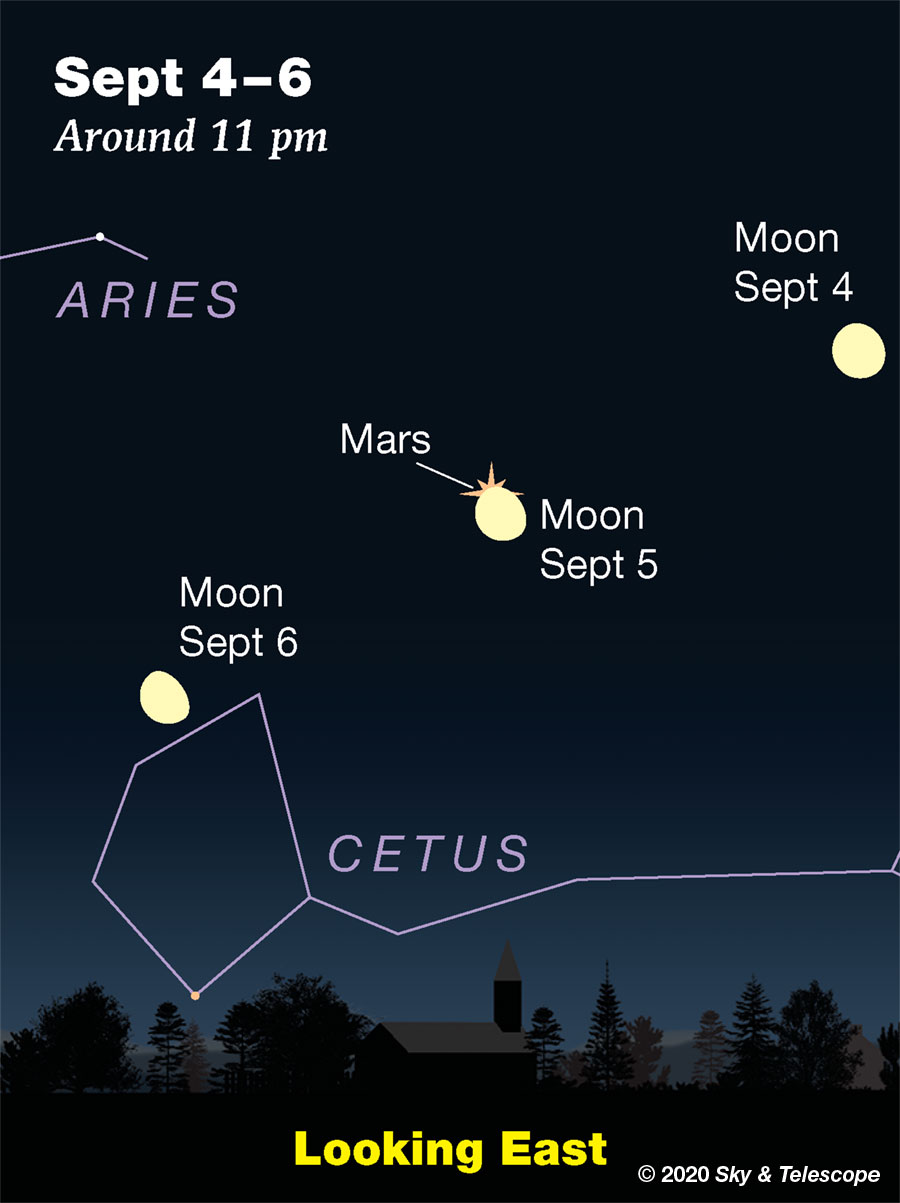
SATURDAY, SEPTEMBER 5
■ The Moon and Mars rise close together in the east about a half hour after the end of twilight. For skywatchers in North America they'll be only about 1° apart or less. By dawn Sunday, they'll stand high in the southwest 2° or 3° apart.
■ Jupiter's Great Red Spot should transit Jupiter's central meridian around 10:18 p.m. Eastern Daylight Time. It should be visible for about an hour before and after in a good 4-inch telescope if the atmospheric seeing is sharp and steady. A light blue or green filter helps.
The Red Spot transits about every 9 hours 56 minutes. But not quite like clockwork! It drifts east or west in Jupiter's atmosphere somewhat irregularly. A changes often becomes detectable to visual transit timers over a span of several months. Our transit-time predictions are based on fairly recent observations, but don't be surprised if the Red Spot has taken it into its head to drift a few minutes off schedule.
SUNDAY, SEPTEMBER 6
■ This evening we get about an hour of good darkness between the end of twilight and the rising of the Moon. Use it to get out your binoculars and explore the small Milky Way star cloud known as M24, in Sagittarius north of the Teapot. It's roughly 1° wide. What you're actually looking into here is a "tunnel in space," as Matt Wedel notes in his September Binocular Highlight (September Sky & Telescope, page 43, with chart). Interstellar dust clouds generally block our view deep into the Milky Way's plane. But "M24" is a lucky lineup of gaps in the clouds for some 10,000 to 16,000 light-years, roughly halfway to the Milky Way's central region. No wonder the stars here are so rich!
MONDAY, SEPTEMBER 7
■ A winter preview: Step out before the first light of dawn this week, and the sky, (with a waning Moon) displays the same starry panorama it does at dinnertime around New Year's. Orion is striding up in the southeast, with Aldebaran and the Pleiades high above it. Sirius sparkles far down below Orion. The Gemini twins are lying on their sides well up in the east.
TUESDAY, SEPTEMBER 8
■ Most variable stars for amateur telescopes take days to weeks to change brightness noticeably. But the fastest eclipsing binary stars can change visibly within 10 minutes. A selection of such fast eclipsers, with finder charts, await you and your scope in Bob King's new article Take a Roller Coaster Ride on a Fast Eclipsing Binary.
Years ago, I would spend hours through a quiet night carefully noting the changing magnitude of some such faint star for the AAVSO's Eclipsing Binary Section. I was using a homemade 6-inch reflector on my parents' lawn with just my eye and an AAVSO comparison-star chart, having planned things out with a list of eclipse predictions. The purpose was, and is, to track any slight drifts in the times of mid-eclipse from the predicted times, indicating tiny changes in the stars' orbital period across months or years. Such changes can reveal mass exchanges, either steady or sudden; the influence of an unseen, third orbiting companion; changes intrinsic to one of the stars, or other effects.
Nowadays amateurs do this with greater precision and reliability using electronic imaging. But for me, that visual program was really what turned me into a serious amateur astronomer.
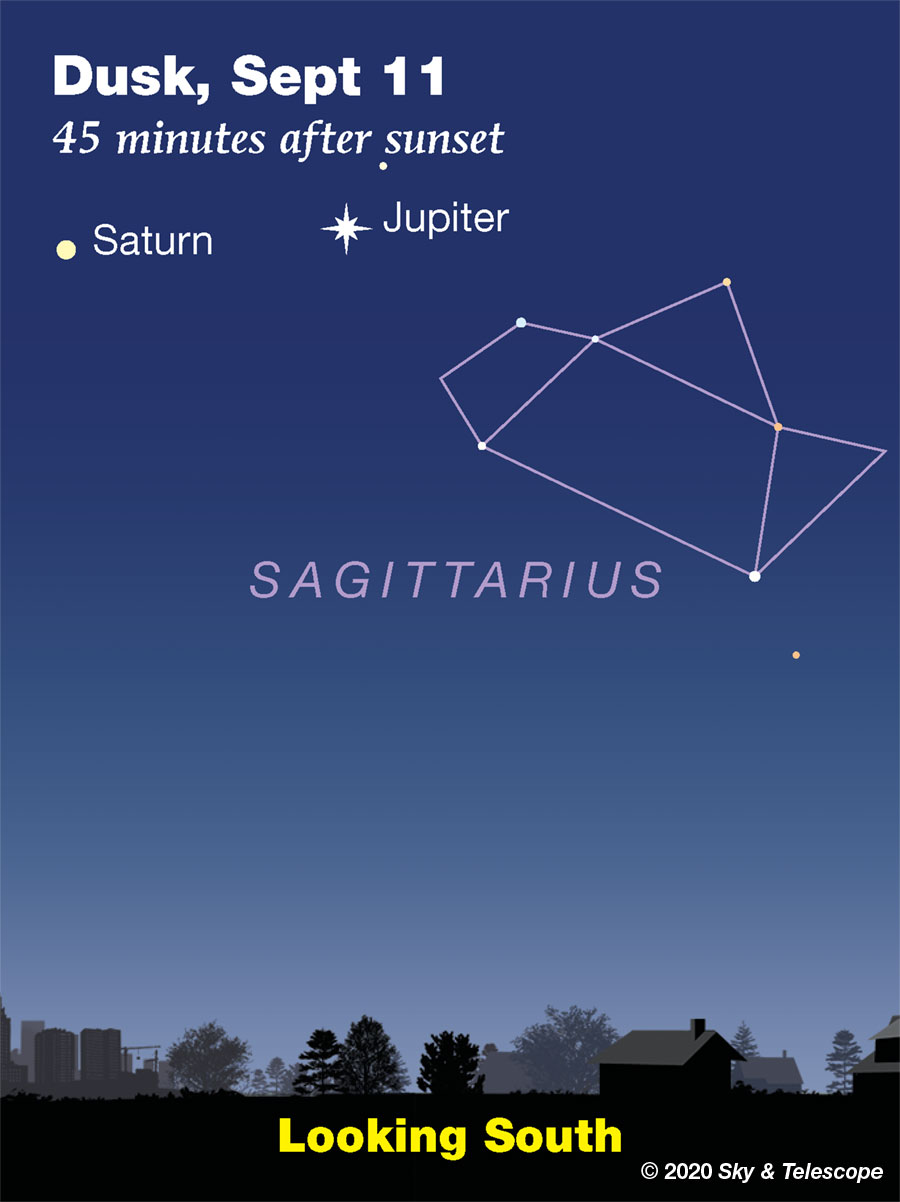
WEDNESDAY, SEPTEMBER 9
■ The last-quarter Moon rises around 11 tonight daylight-saving time, depending on your location. The Pleiades are less than a fist at arm's length above it, and, once the Moon is a little higher, you'll spot orange Aldebaran below it or to its lower left.
The Moon is exactly last-quarter at 5:26 a.m. Thursday morning EDT. By dawn Thursday it's very high in the south, still between Aldebaran and the Pleiades. Lower left of them stands Orion.
THURSDAY, SEPTEMBER 10
■ The wide W pattern of Cassiopeia is tilting up in the northeast these nights. Look below the W's last segment, the one on the lower left, by a little farther than the segment's length. Can you see an enhanced little spot of the Milky Way's glow here? Binoculars will show it to be the Perseus Double Cluster — even through a fair amount of light pollution.
■ Jupiter's Great Red Spot should transit around 9:27 p.m. Eastern Daylight Time.
FRIDAY, SEPTEMBER 11
■ Vega now passes the zenith an hour after sunset during late twilight, for those of us at mid-northern latitudes. Vega is bigger, hotter, and 50 times brighter than our Sun. But at a distance of 25 light-years, it's 1.6 million times farther away. The Sun is only 8.3 light-minutes from us.
SATURDAY, SEPTEMBER 12
■ By 9 or 10 p.m. two of the best-known deep-sky objects, the Double Cluster in Perseus (see Thursday above) and the Great Andromeda Galaxy M31, are in high view in the east. Did you know they're only 22° apart? They're both cataloged as 4th magnitude but to the naked eye they look rather different, the more so the darker your sky. See for yourself; they're plotted on the all-sky constellation map in the center of the September Sky & Telescope, which should be all the map you need to identify their locations. They're below Cassiopeia and farther to Cassiopeia's right, respectively. Sky too bright? Use binoculars!
The two clusters of the Double Cluster (NGC 869 and NGC 884) are at very similar distances about 7,600 light-years away. M31, at 2.5 million light-years, is about 330 times farther.
This Week's Planet Roundup
Mercury is buried deep in the sunset.
Venus (magnitude –4.2, in dim Cancer) rises in deep darkness two hours before dawn begins, a weird UFO in the east-northeast below Castor and Pollux. By the time dawn gets under way, Venus shines fairly high in the east.
In a telescope Venus continues to shrink (it's now about 19 arcseconds in diameter) while becoming more gibbous (61% sunlit).
Mars is big, bright and close as it nears its October 13th opposition. This week it rises bright orange — shining at magnitude –2.0! — in the east soon after the end of twilight. It climbs higher through the evening and stands at its highest and telescopic best around 3 or 4 a.m. daylight-saving time, lording over the world from high in the south. This week Mars grows from 19 to 20 arcseconds in apparent diameter, nearly as big as it will be when passing closest by Earth a month from now.
Mars is still noticeably gibbous, 94% sunlit. Look for its white South Polar cap, possible clouds especially near the limb, and dusky surface markings. To get a map of the side facing Earth at the date and time you'll observe, you can use our Mars Profiler. The map there is square; remember to mentally wrap it onto the side of a globe. (Features near the map's edges become very foreshortened.)
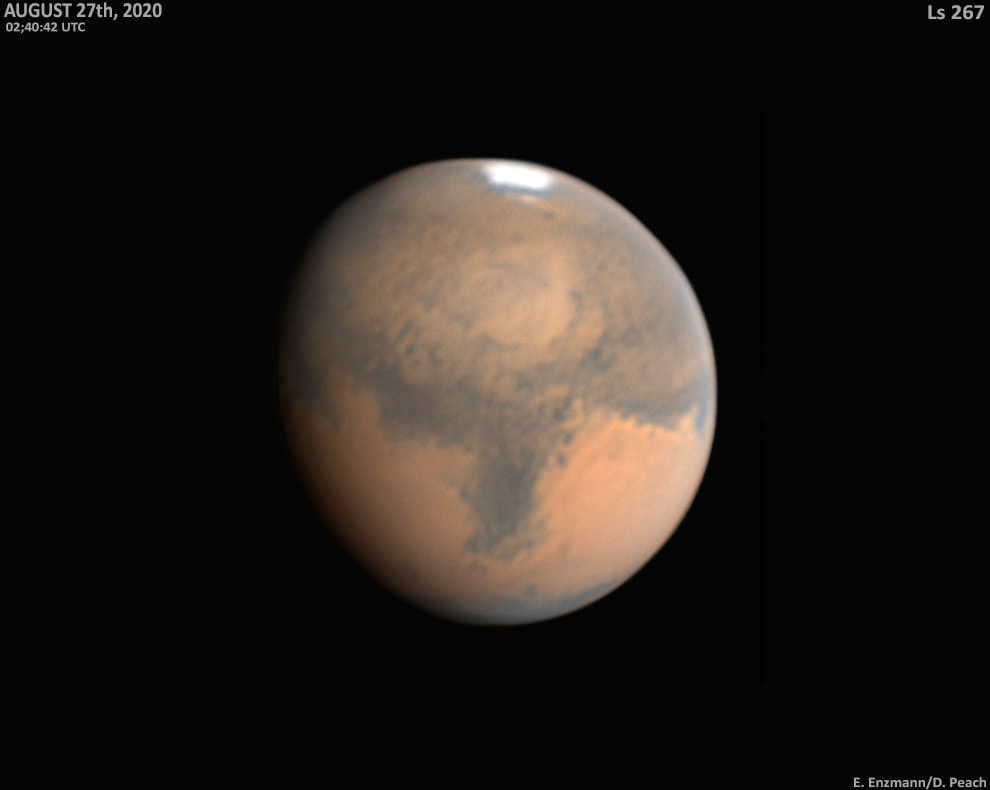
The South Polar Cap continues to shrink, and just off its edge, only a little remains of Novus Mons. In an image Enzmann and Peach took just six days earlier, the Novus Mons patch was sharply defined and starkly white.
Jupiter and Saturn (magnitudes –2.5 and +0.3, respectively) shine in the south in early evening. Jupiter is the brightest. Saturn remains 8° to its left.
They turn perfectly horizontal during twilight. Lower right of Jupiter after dark is the handle of the Sagittarius Teapot. The brightest star of the Teapot's handle (the top one) is Sigma Sagittarii or Nunki, magnitude 2.0. It's a hot blue-white star, 4.5 times the Sun's diameter, 3300 times as luminous, and 230 light-years away.
Follow the telescopic interplay of Jupiter with its moons and their shadows, and find all the transit times of Jupiter's Great Red Spot, in the Celestial Calendar section of the September Sky & Telescope, page 50.
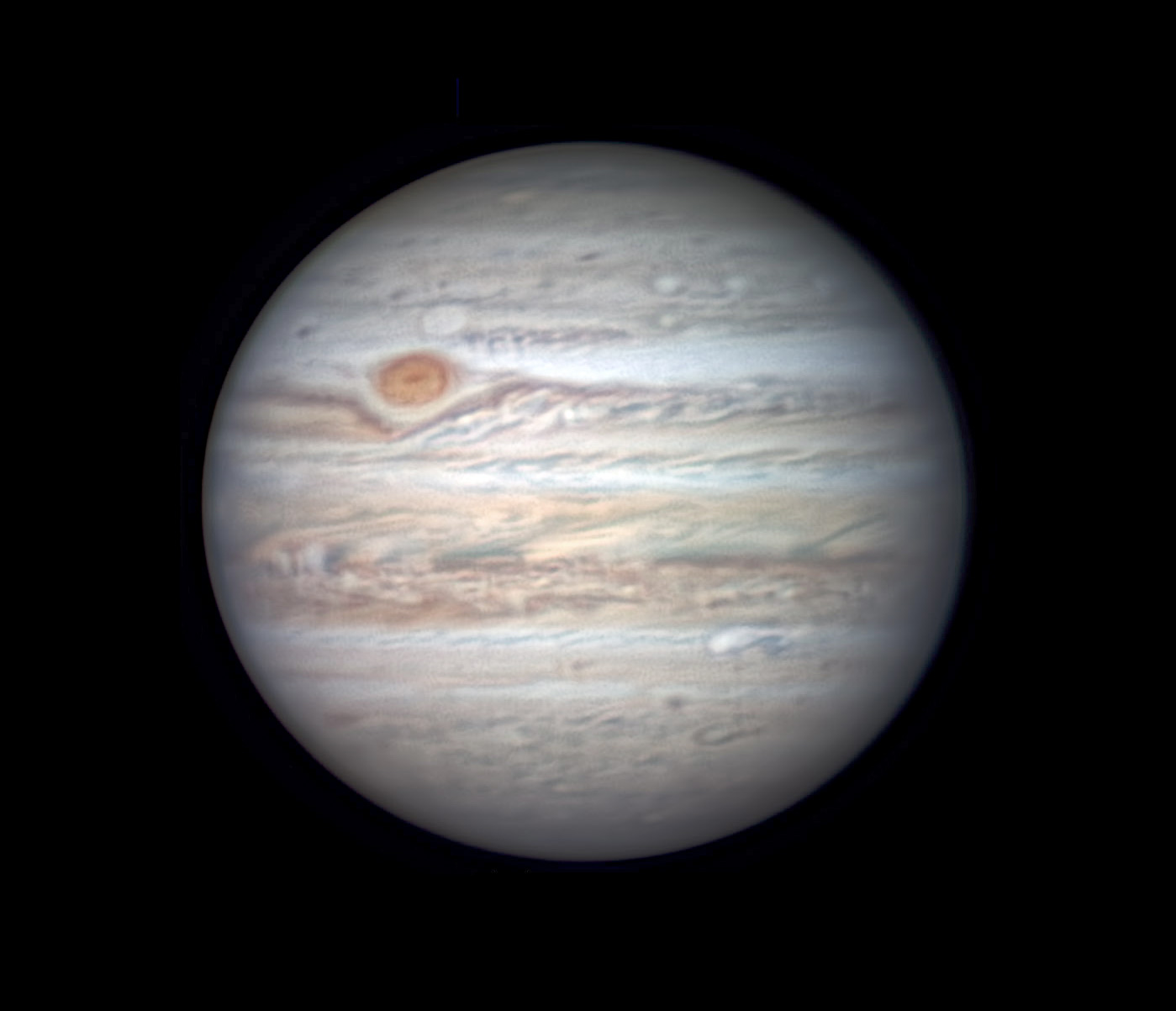
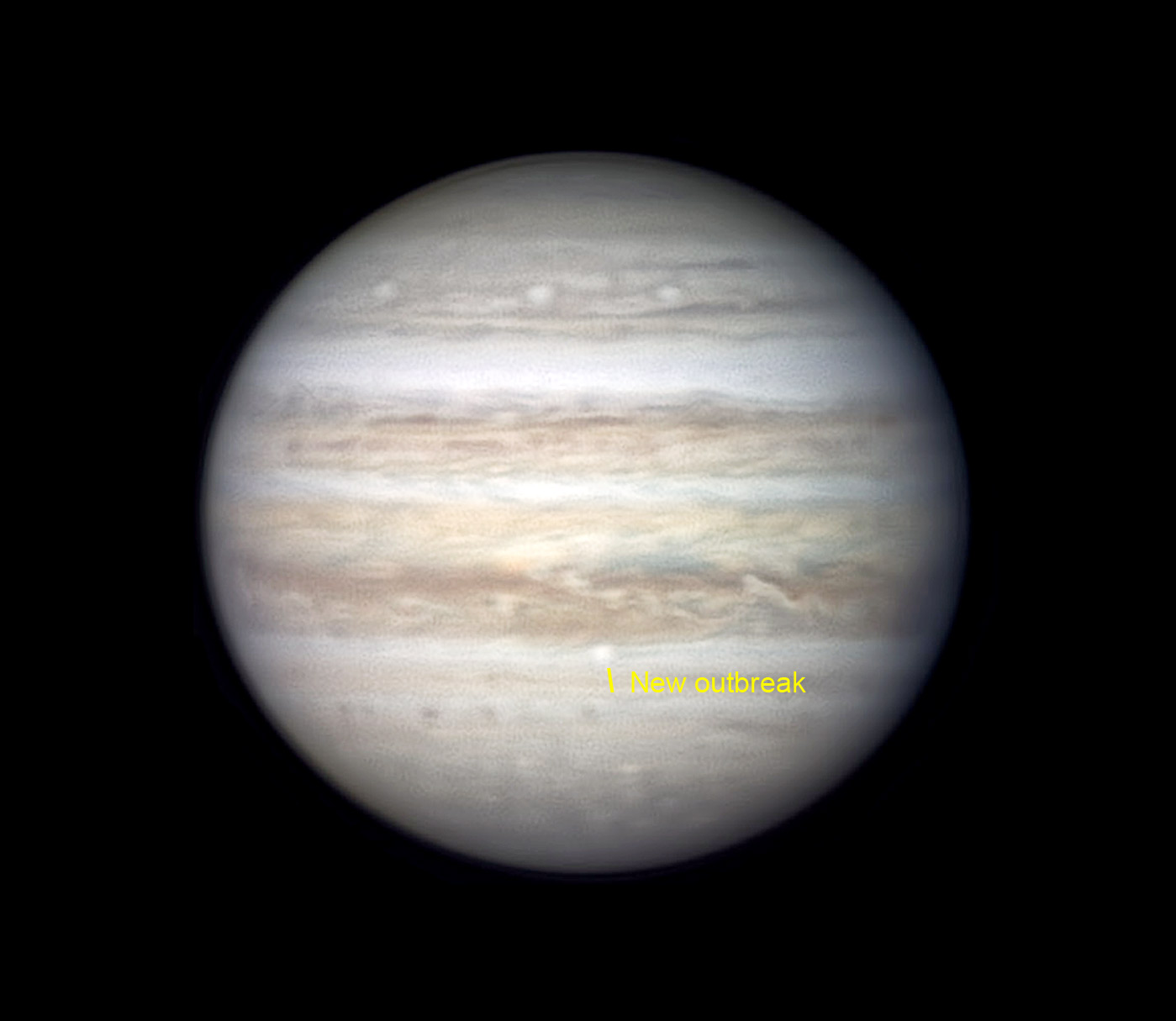
Uranus (magnitude 5.8, in Aries) is well up in the east by midnight daylight-saving time, east of Mars.
Neptune (magnitude 7.8, in Aquarius) is higher in the south-southeast by that time. Finder charts for Uranus and Neptune.
All descriptions that relate to your horizon — including the words up, down, right, and left — are written for the world's mid-northern latitudes. Descriptions that also depend on longitude (mainly Moon positions) are for North America.
Eastern Daylight Time, EDT, is Universal Time (also known as UT, UTC, GMT, or Z time) minus 4 hours.
Want to become a better astronomer? Learn your way around the constellations. They're the key to locating everything fainter and deeper to hunt with binoculars or a telescope.
This is an outdoor nature hobby. For an easy-to-use constellation guide covering the whole evening sky, use the big monthly map in the center of each issue of Sky & Telescope, the essential magazine of astronomy.
Once you get a telescope, to put it to good use you'll need a detailed, large-scale sky atlas (set of charts). The basic standard is the Pocket Sky Atlas (in either the original or Jumbo Edition), which shows stars to magnitude 7.6.

Next up is the larger and deeper Sky Atlas 2000.0, plotting stars to magnitude 8.5; nearly three times as many. The next up, once you know your way around, are the even larger Interstellarum atlas (stars to magnitude 9.5) or Uranometria 2000.0 (stars to magnitude 9.75). And read how to use sky charts with a telescope.
You'll also want a good deep-sky guidebook, such as Sky Atlas 2000.0 Companion by Strong and Sinnott, or the bigger (and illustrated) Night Sky Observer's Guide by Kepple and Sanner.
Can a computerized telescope replace charts? Not for beginners, I don't think, and not on mounts and tripods that are less than top-quality mechanically, meaning heavy and expensive. And as Terence Dickinson and Alan Dyer say in their Backyard Astronomer's Guide, "A full appreciation of the universe cannot come without developing the skills to find things in the sky and understanding how the sky works. This knowledge comes only by spending time under the stars with star maps in hand."
![]() Audio sky tour. Out under the evening sky with your
Audio sky tour. Out under the evening sky with your
earbuds in place, listen to Kelly Beatty's monthly
podcast tour of the heavens above. It's free.
"The dangers of not thinking clearly are much greater now than ever before. It's not that there's something new in our way of thinking, it's that credulous and confused thinking can be much more lethal in ways it was never before."
— Carl Sagan, 1996
"Facts are stubborn things."
— John Adams, 1770
 6
6









Comments
Yaron Sheffer
September 4, 2020 at 5:40 pm
This year is special, for in December 2020 we will see faster Jupiter catch up with Saturn and then leave it behind (in the Zodiacal dust?) for the next 20 years. This event last happened in 2000, and should repeat in 2040, 2060, etc. A truly six times in a lifetime experience!
You must be logged in to post a comment.
Rod
September 5, 2020 at 8:15 am
mary beth et al. Last night after 2200 EDT, I was able to enjoy some Saturn, Jupiter, waning gibbous Moon, and Mars observing using my 90-mm refractor telescope at 129x. There were some guest over so I got to share the views. Folks really enjoyed seeing Jupiter, the 4 Galilean moons, cloud bands, Saturn ring system and Titan distinct. They could also see some of Saturn's shadow on the ring system. There were lunar craters very visible near the terminator line and Mars (2300 EDT) showed some distinct surface features. A fun time.
You must be logged in to post a comment.
mary beth
September 7, 2020 at 1:13 pm
Hi Rod I’m so glad you got to enjoy a nice evening with guests. I bet they really enjoyed the viewing through the telescope. I remember the first time I saw Saturn in a telescope I literally thought someone had put a cartoon inside the telescope to fool me, it was so surreal! As a teenager I thought it looked just like something out of the Jetsons!
You must be logged in to post a comment.
Rod
September 6, 2020 at 9:15 am
I hope folks enjoyed some outdoor evening time last night (Sep-05). It was gorgeous here where I am at! I was out in my east pasture from 2000-2300 EDT. The big ticket items were viewing Jupiter and Saturn in Sagittarius. I used the 90-mm refractor and 10-inch, comparing views of these planets from 40x to 120x. The 10-inch showed 5 moons near Saturn, including Enceladus, excellent views of Cassini division, some cloud bands (I used #12 yellow filter), and some of the planet's shadow cast on the rings. The 90-mm refractor showed two Saturn moons. Jupiter's Great Red Spot became visible near 2040 EDT and crossed the central meridian of Jupiter near 2218 EDT as reported by Sky & Telescope. The 10-inch using #58 Green filter made viewing very easy, and tracking the Great Red Spot position changes on Jupiter as Jupiter rotated. About 2050 EDT, the Milky Way was very obvious running from Cygnus through Sagittarius with Jupiter and Saturn there. No dark sky view but still a pretty good show. Another great viewing treat was observing the waning gibbous Moon and Mars rise in Pisces. At 2213 EDT, on a road near a very large horse pasture, I enjoyed unobstructed unaided eye views of the pair, clear of a group of trees near my east pasture. Mars about 1-degree angular separation from the Moon. Observing the Moon and Mars through a number of hours during the night, you could see the position angle and separation of Moon and Mars take place. The Moon orbits Earth faster than the Earth rotates, a simple way of testing the Earth rotation and lunar orbital velocity. Both Mars and Moon will set after rising but the Moon is orbiting faster than Earth spins, moving faster so the angular separation and position angle of Mars changed relatively quickly while viewing periodically during the night. Out on the road, I could see the Moon, Mars, all along the ecliptic to Saturn and Jupiter position, and Sagittarius. Some excellent planet viewing last night----Rod
You must be logged in to post a comment.
mary beth
September 7, 2020 at 1:15 pm
Hi Rod! Sounds like a another amazing night. I am going to get on Stellarium site/app and back date so I can follow what you saw. Thank you for the great description and explanation! Also for recommending Stellarium.....I LOVE it!
You must be logged in to post a comment.
Rod
September 8, 2020 at 9:08 am
mary beth, glad to hear you enjoy Stellarium. Early this morning, 0400-0500 UT (midnight until 0100 EDT), I enjoyed Mars views at 200x and using a #23A red filter too. Very distinct surface dark bands visible and Hellas Planitia. I used Starry Night simulation view and the Mars Profiler in the S&T report is very good too. Mars is strutting about and showing off now as the planet approaches opposition in October 🙂 Mars about 20 arcsecond size so small telescopes can provide some very good views now.
You must be logged in to post a comment.
You must be logged in to post a comment.